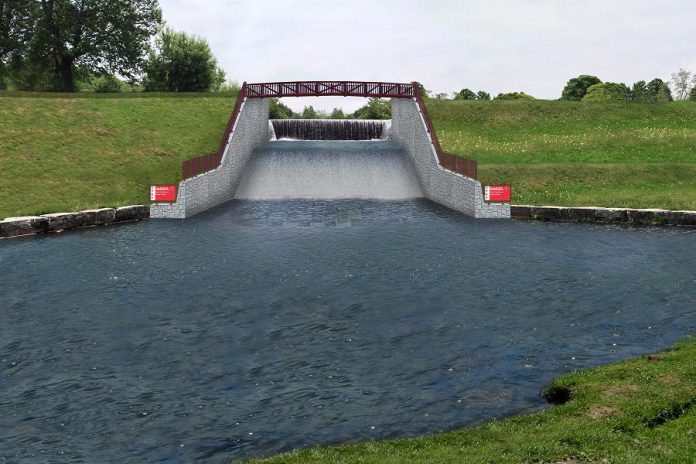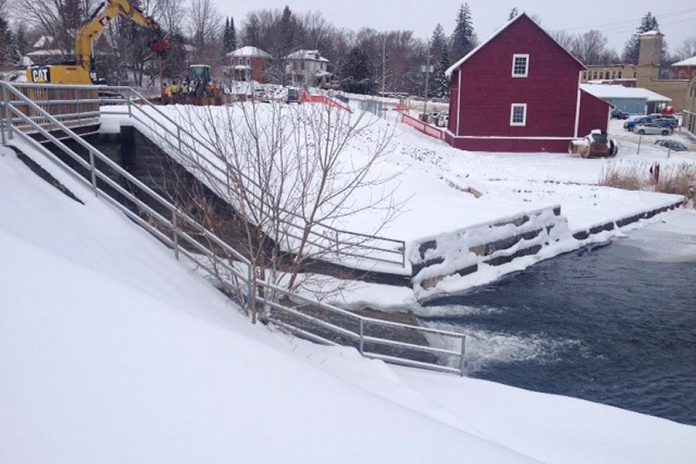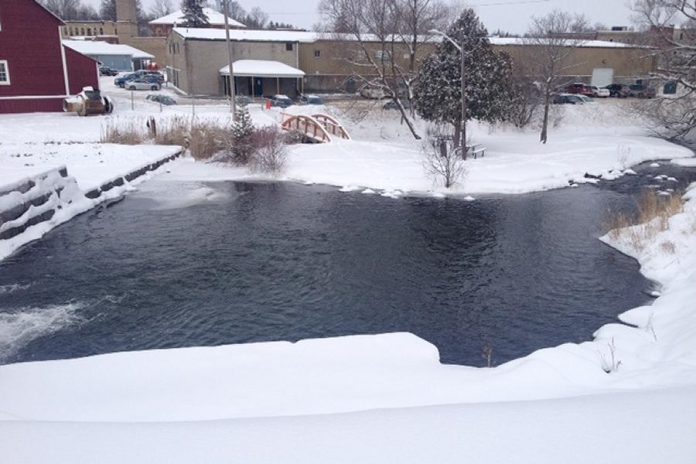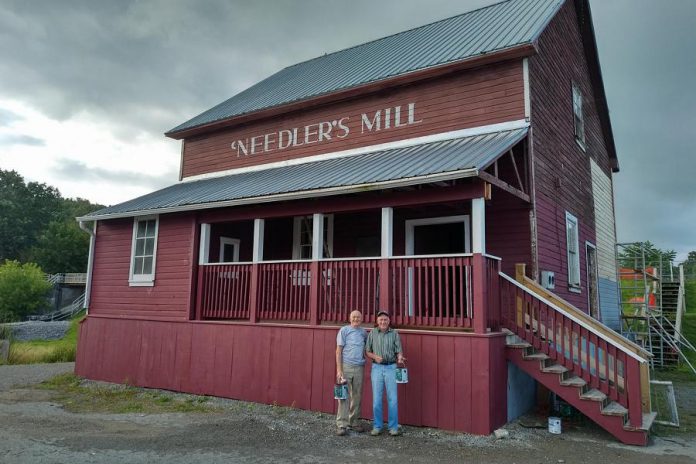
It has been a long time coming but reconstruction of the aging Millbrook Dam has begun, the end result destined to not only reduce the likelihood of flooding of the village’s core but also ensure the preservation of a cultural landmark.
On Thursday morning (February 8) at the Millbrook Arena, there was representation from all levels of government as details of the project were highlighted by Otonabee Conservation Chief Administrative Officer Dan Marinigh.
A total of $3.8 million has been budgeted for the replacement of the 200-year-old dam, scheduled to be complete in October in the shadow of historic Needler’s Mill, with $1.1 million each forwarded by the federal and provincial governments and the rest by Cavan Monaghan Township.
Ontario-based Facca Incorporated was awarded the contract last October.
“It’s the historic foundation of this community; it helps make it their place,” said Marinigh of the landmark-worthy significance of the site, adjacent to the arena and just around the corner from Millbrook’s main intersection.
“Millbrook is about a mill on a brook. Its identity is associated with a mill, a dam, and a pond. You really undermine that identity if you take the mill away from the pond, or you take the dam away from the mill.”
Earlier, Marinigh previewed the work to be done, which includes:
- Construction of temporary coffer dams and a flow diversion structure to maintain an open creek channel
- Removal of the existing concrete, wood and sheet pile spillways as well as the u-shaped weir and steel bridge
- Construction of a new reinforced concrete weir, spillway and stilling basin
- Hardening of the earthen embankment portion of the dam
- Installation of a public walkway and landscaping of the site.
“Environmental assessments have to consider three environments — the economic environment, the natural environment and the cultural environment,” added Marinigh.
“The driving environment here was the cultural environment. This acknowledges the cultural aspirations of the community and it’s making it much more safe.”
He added the impact on the pond’s denizens has been studied extensively and is a major consideration in the planned phases of the work.
“We did a turtle survey all last year. There are some snapping turtles here, but there are no endangered species. We’ve got exclusion fencing to stop them from getting on shore and setting nests, at least during the construction period. In addition, we’re going to trap, capture and release fish — Brown Trout in the pond, Brook Trout in the creek below the pond — to get them outside of the work area.”

As for pond sediment, it will be removed this summer by shovels on barges.
The largest capital project ever undertaken by Otonabee Conservation, it has eclipsed the mid-1980s construction of a weir on Jackson Creek for that distinction.
“Big projects that get recognition reinforce to (Otonabee Conservation) staff the value of their work. It’s kind of like a Super Bowl for us. It’s a big game.”
Earlier, Ontario Conservation Vice-Chair Sherry Senis stressed the significance of the dam’s reconstruction, noting the project has been subject of board discussion and debate for several years.
“I’ve been on the board for 12 years and for those 12 years, every year, this was a topic of conversation, sometimes very painful,” she said in expressing her delight the work has started.

Following Senis’ opening remarks, which included the reading of a statement from federal Infrastructure and Communities Minister Amarjeet Sohi, a number of local politicians took to the podium.
“Without getting into a broad discussion about climate change, we do know one thing for sure: we’re more and more experiencing volatile weather conditions, whether it’s drought or severe rains, and we’ve got to prepare,” said Peterborough MPP Jeff Leal, adding aging infrastructure in rural municipalities provides a unique challenge.
“This investment will help ensure that residents have access to the re-instated pedestrian path and bridge over the dam. It will also ensure the historical characteristics of the dam remain intact.”
Echoing those comments were Haliburton-Kawartha Lakes-Brock MP Jamie Schmale and MPP Laurie Scott, Peterborough County Warden Joe Taylor, and Cavan Monaghan Mayor Scott McFadden.
“It’s going to make Millbrook a better village; it’s going to make Peterborough County a better place,” said Taylor, with Mayor McFadden terming the dam and its surrounding landscape “a social gathering place” for both residents and visitors before commending the Save The Dam Mill Pond movement for its voice and diligence.
On February 23, 2018, Needler’s Mill will officially become the property of the Millbrook and Cavan Historical Society when representatives from the society and Otonabee Conservation sign the official agreement at a public gathering in the Legion Hall. Once the work on the Millbrook Dam is completed, the society and Otonabee Conservation will be designing and installing interpretive historical panels beside the mill.

During his formal presentation, Marinigh said the reconstruction is “a complex project” for three reasons: maintaining public safety during the work, ensuring the archaeological integrity of the site isn’t disturbedm and keeping the protection of wildlife front of mind.
Marinigh added work actually started about a month ago with the removal of a steel pipe in the dam that fed the pond, with a diversion channel constructed in its place.
Excavation and widening is expected to start in April, followed by construction of the dam’s new structure proper, the strengthening of earthen embankment, and the removal of the temporary water diversion measures.
“We completed the beginning; now we’re at the beginning of the end,” he said.
When done, the spillway will be wider at 12 metres but the size and water level of the pond will remain as is, with Otonabee Conservation assuring “waterfall sights and sounds will be very similar to existing conditions.”


























